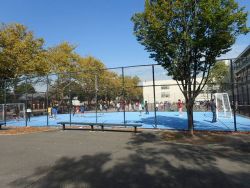Hillside Playground
Hillside Park
This playground is located in the Glen Oaks neighborhood of eastern Queens. The name reflects the nearby crest of hills that form the highest elevation on Long Island. Once a part of Flushing, Glen Oaks itself is named after a golf course erected here in the 1920s that has since made way for high-rise apartment buildings.
Glen Oaks was originally a piece of flat terrain on the south side of the hills that form the backbone of geographic Long Island. This fertile soil, part of a 20,000-acre land grant to Massachusetts settlers, was eagerly sought by farmers in the 1640s. It retained a largely rural character until, in 1923, a new golf club purchased 167 acres from William K. Vanderbilt’s country estate.
In 1944, the Gross-Morton Company bought 175 acres of land along Union Turnpike and, with a loan of $24 million from the Federal Housing Authority, built Glen Oaks Village. This 3000 unit garden apartment complex consisted of a series of two-story buildings built in the Colonial style. The neighborhood soon filled with veterans of World War II and continued to grow in the following decades. In 1972, the construction of North Shore Towers, three 33-story apartment buildings on the defunct Glen Oaks golf course, was announced, with construction completed in 1974.
The Glen Oaks community’s proximity to the Nassau County line has made it essential for locals to develop an identity of their own, one that blends residence in an urban borough with the suburban realities of life near Long Island. Recently, residents have joined other neighborhoods similarly seeking a balance between their urban and suburban characteristics to form the “Lost Community Civic Association,” which fights for local issues from inadequate drainage to parking shortages.
The City of New York acquired this land, located at 82nd Avenue and 256th Street, in 1948. Originally called J.H.S. 172 Playground, it was renamed by Commissioner Stern in 1985 after nearby Hillside Avenue. In 1998, Council Member Sheldon S. Leffler sponsored a $875,000 reconstruction of the park. Today, the park contains two handball courts, swings, play equipment, a spray shower, a public restroom, and a flagpole with a yardarm, as well as four full-size basketball courts, two of which double as tennis courts. London planetrees (Platanus x acerifolia) line the perimeter of the park.
Check out your park's Vital Signs
Clean & Safe
Green & Resilient
Empowered & Engaged Users
Share your feedback or learn more about how this park is part of a
Vital Park System

